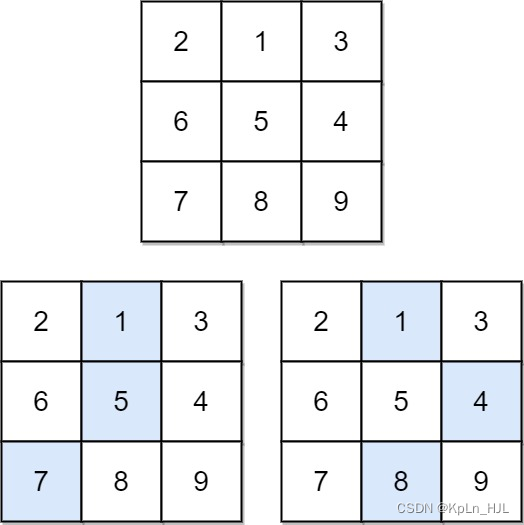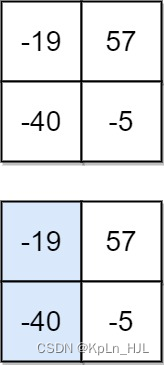leetcode - 931. Minimum Falling Path Sum
Description
Given an n x n array of integers matrix, return the minimum sum of any falling path through matrix.
A falling path starts at any element in the first row and chooses the element in the next row that is either directly below or diagonally left/right. Specifically, the next element from position (row, col) will be (row + 1, col - 1), (row + 1, col), or (row + 1, col + 1).
Example 1:

Input: matrix = [[2,1,3],[6,5,4],[7,8,9]]
Output: 13
Explanation: There are two falling paths with a minimum sum as shown.
Example 2:

Input: matrix = [[-19,57],[-40,-5]]
Output: -59
Explanation: The falling path with a minimum sum is shown.
Constraints:
n == matrix.length == matrix[i].length
1 <= n <= 100
-100 <= matrix[i][j] <= 100
Solution
Simple dp. The transformation equation is:
d
p
[
i
]
[
j
]
=
min
?
(
d
p
[
i
+
1
]
[
j
?
1
]
,
d
p
[
i
+
1
]
[
j
]
,
d
p
[
i
+
1
]
[
j
+
1
]
)
dp[i][j] = \min(dp[i+1][j-1], dp[i+1][j],dp[i+1][j+1])
dp[i][j]=min(dp[i+1][j?1],dp[i+1][j],dp[i+1][j+1])
Time complexity:
o
(
n
2
)
o(n^2)
o(n2)
Space complexity:
o
(
n
2
)
o(n^2)
o(n2), could be reduced to
o
(
n
)
o(n)
o(n)
Code
class Solution:
def minFallingPathSum(self, matrix: List[List[int]]) -> int:
n = len(matrix)
dp = [[100] * n for _ in range(n)]
dp[-1] = matrix[-1].copy()
max_val = 1000001
for i in range(n - 2, -1, -1):
for j in range(n):
if j - 1 >= 0:
left_val = dp[i + 1][j - 1]
else:
left_val = max_val
if j + 1 < n:
right_val = dp[i + 1][j + 1]
else:
right_val = max_val
dp[i][j] = matrix[i][j] + min([dp[i + 1][j], left_val, right_val])
return min(dp[0])
本文来自互联网用户投稿,该文观点仅代表作者本人,不代表本站立场。本站仅提供信息存储空间服务,不拥有所有权,不承担相关法律责任。 如若内容造成侵权/违法违规/事实不符,请联系我的编程经验分享网邮箱:chenni525@qq.com进行投诉反馈,一经查实,立即删除!
- Python教程
- 深入理解 MySQL 中的 HAVING 关键字和聚合函数
- Qt之QChar编码(1)
- MyBatis入门基础篇
- 用Python脚本实现FFmpeg批量转换
- 【C++PCL】点云处理欧式聚类分割
- Gateway服务网关
- 如何解决浏览器提示“SSL协议未开启”?
- linux java环境安装
- 报文、报文段、数据包/分组、数据帧 --概念和区别
- 【计算机网络】URL概念及组成
- 私域要做成交,离不开这5个核心
- 几种常见的模态框
- Laravel中的lockForUpdate悲观锁
- 代码随想录算法训练营第五十六天 _ 动态规划_583.两个字符串的删除操作、72.编辑距离、647.回文子串、5. 最长回文子串。